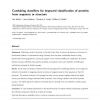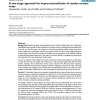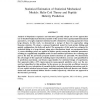48 search results - page 3 / 10 » Protein structural class prediction based on an improved sta... |
BMCBI
2006
13 years 7 months ago
2006
Background: We describe Distill, a suite of servers for the prediction of protein structural features: secondary structure; relative solvent accessibility; contact density; backbo...
BMCBI
2008
13 years 7 months ago
2008
Background: Predicting a protein's structural or functional class from its amino acid sequence or structure is a fundamental problem in computational biology. Recently, there...
BMCBI
2006
13 years 7 months ago
2006
Background: Protein topology representations such as residue contact maps are an important intermediate step towards ab initio prediction of protein structure. Although improvemen...
JCB
2007
13 years 7 months ago
2007
Analysis of biopolymer sequences and structures generally adopts one of two approaches: use of detailed biophysical theoretical models of the system with experimentally-determined...
ISMB
1994
13 years 8 months ago
1994
Weconsider the problem of parsing a sequence into different classes of subsequences.Twocommonexamplesare finding the exons and introns in genomicsequences and identifying the seco...



